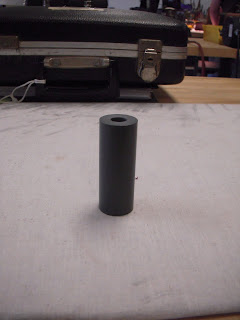Beginning Adventures with the Lathe
The first
project we did with the lathe was a rotor bearing seater (or a piece of PVC.) We had to face both ends with a file,
bevel slightly, and drill a hole into one end. Simple, sweet and useful.
Second Lathe Project
Our second
lathe project was a flute push rod, or another piece of plastic with a hole in
one end. But this time, there's a line scribed on the other end. The facing
and the drilling were the same from the last project; the line scribing was the
new skill.
The line had to be
exactly 17 millimeters from the end (it's used to measure whether the head cork
in a flute is in the correct position or not. If the line isn't dead center
when you look through the embourche hole, your head cork is in the wrong spot
and the flute won't play correctly). To make sure the line was exactly where we
needed it to be, we pulled our calipers out to the exact length and locked it in
place. While the lathe was running, we touched the end of the calipers onto the
end of the plastic and the sharp part of the jaws scored the line.
After scoring, we
took a 60 degree bit and set it up so that it was exactly in the center of the
caliper line and advanced (with the lathe running) until the edge of the bit hit
the plastic and shut everything off. We then adjusted the micrometer to zero,
turned everything back on and scribed our line to the exact measurement without
guessing how far we've gone.
Since the piece of
plastic is white, the scribe line is hard to see so we used guilding crayons to
fill in the gap and make the line stand out.





No comments:
Post a Comment